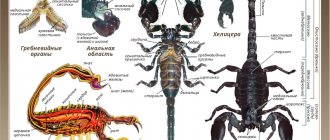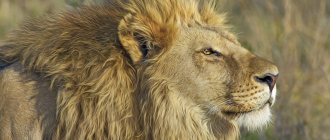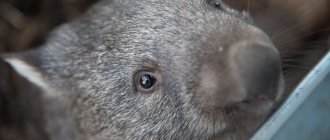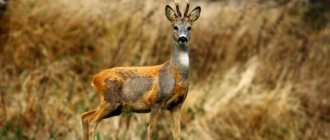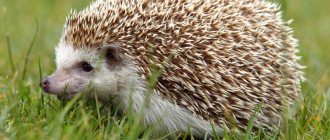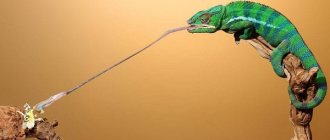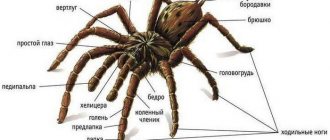General overview
Scorpions (Latin name - Scorpionidea) belong to the oldest order of arthropods or arthropods of the arachnid class. In total, there are approximately 1,750 species of these animals, but only 50 of them have poison that is fatal to humans. Scorpions are distinguished by their speed of movement and never attack people first; if this happens, it is only for the purpose of self-defense.
Structural features
The animal has a small but rather wide cephalothorax, tapering downward. An abdomen consisting of several segments is attached to it. There is a pair of claws nearby, with which the animal captures prey. In the mouth area there are rudimentary limbs that act as jaws (mandibles). At the bottom of the abdomen there are four pairs of legs, through which the scorpion quickly moves along any surface, depending on the area where it lives. These could be rocks in the mountains or quicksand in the desert.
The long abdomen of the arthropod gradually narrows, thereby forming a tail. At its end there is a small pear-shaped capsule segment. Inside it are glands that produce poison, and at the end there is a sharp needle, with the help of which the scorpion injects a poisonous substance into its victim. Since the animal’s body is covered with a strong chitinous shell, it is practically not in danger from enemies.
Scorpios have very well developed vision, which allows them to see even at night. In the upper part of the cephalothorax there are eyes; depending on the type of arthropod, there can be from 2 to 12 of them. One pair, located in the middle, is the largest and is called the middle eyes. The remaining eyes are called lateral and are located near the anterior edge of the cephalothorax.
The color of a scorpion directly depends on the area of residence. There are the following options:
- grey;
- orange;
- colorless-transparent;
- black;
- green;
- yellow-sand;
- violet.
The animal's shell is covered with a very thin layer of organic matter, which is highly durable.
Origin and habitat
The first scorpions living on earth appeared more than 300 million years ago (during the Devonian period). The fact that during this time they remained unchanged is confirmed by the imprints of their bodies on hard rocks. Their very first representatives lived in coastal waters, gradually getting used to the land way of life.
Modern species of these arthropods appeared 100 million years ago. To date, scorpions have not been studied well enough. Many people classify these specimens as insects due to their large number of double legs and the ability to sting like a wasp. However, this opinion is not considered correct. Scorpions are animals that reproduce live offspring, that is, viviparous.
The diversity of their species is determined by their habitat and natural area. You can meet scorpions in different places, with the exception of the Far North. The ideal conditions for these arthropods to live are the tropics and subtropics with a hot climate or warm temperate regions:
- Spain;
- Italy;
- Crimea;
- Caucasus;
- Volga region;
- Turkestan;
- Central Korea;
- southern part of the USA.
Scorpions prefer to be nocturnal; during the day they hide from the sun under rocks, in gorges, or simply bury themselves in the sand. As night falls, animals crawl out of their shelters to start hunting.
Hunting specifics
Scorpio easily obtains food for itself, having the ability to sit motionless for hours, waiting for prey. When an insect appears, it quickly rushes at it and securely covers it with its claws. Scientists have found that scorpions detect the presence of potential prey at a distance of 30 cm. In doing so, they use not their eyes, but hairs located on their paws, which are highly sensitive and are of great importance for individuals.
By its nature, this arthropod is a predator; it eats the following insects:
- spiders;
- cockroaches;
- centipedes;
- grasshoppers.
In addition, a scorpion can feed on small rodents, lizards, and even eat its relatives who are weaker than it. Unlike insects, the animal first captures a large prey with its claws and then kills it using a poisonous sting.
Scorpio has a special structure of its digestive system. This allows him to do for some time not only without food, but also without water, usually obtained from the body of his victims.
Reproduction and care of offspring
Once the male is ready to mate, he goes in search of a female. This happens at night. When moving, the “groom” leaves behind a trail of a substance that has a specific odor and attracts the “bride.” The male, in turn, senses the female’s trace through the hairs that are located at the bottom of his body.
Having met, the couple begins a kind of mating game . The “groom” quickly advances toward the “bride,” tapping the ground with his pedipalp limbs. Its raised sting indicates its readiness to mate. Such a sign is necessary so that the female does not mistake him for a possible victim. However, if the “bride” is hungry at that moment or is not ready to mate, she can attack the groom and then eat him.
If mating does occur, it is controlled by the male. Clutching with pincers and moving back and forth, the couple performs a mating dance. Such a game can continue for a long time, then the “groom” leaves the spermatophore in a suitable place and drags the “bride” over it. Thus, sperm from the capsule enter the female genitals.
Most scorpions are viviparous; their fertilized eggs develop in the mother's body. In such conditions, they are completely protected from the negative effects of the environment and potential danger. There are ovoviviparous individuals; their young are hatched from eggs laid by the female.
The gestation period for scorpions ranges from 10 months to 1 year, and the number of offspring varies depending on their species. Usually a female has from 20 to 60 babies, in rare cases - more. Having been born, little scorpions immediately climb onto their mother’s back, where they spend the first and very dangerous days of their lives. Before molting, the babies are white and absolutely helpless. While caring for the offspring, the female leads her usual lifestyle, obtaining food for herself and her children.
After 7-10 days, the scorpion babies have their first molt, and, leaving their mother, they begin an independent life. In its very first months, the offspring molt every 30 days, this happens 3 times. In the future, this process can be observed in them no more than once a year. It takes them several years to reach sexual maturity. During this time they grow, periodically renewing their chitinous cover. The lifespan of scorpions in nature ranges from 7 to 10 years.
Love until the grave: 10 animals that die immediately after mating
Brood size depends on the variety and environmental factors, and can range from two to 100. Young people generally resemble their parents. Growth is achieved by periodic loss of exoskeleton (ecdysis). A scorpion's developmental progression is measured in instar stages (how many molts it has undergone). Scorpions typically molt between five and seven times before reaching maturity. Molting is produced by a split in the old exoskeleton, which occurs just below the edge of the scutellum (in front of the prosoma). Scorpio then emerges from this rift; The pedipalps and legs are first pulled out from the old exoskeleton, followed eventually by the metasoma. When it emerges, the scorpion's new exoskeleton is soft, and makes the scorpion very vulnerable in case of danger. The scorpion must constantly move while the new exoskeleton is strengthened. The process of strengthening is called sclerotization. The new exoskeleton does not fluoresce; as sclerotization occurs and fluorescence gradually returns.
The clinging walk of a scorpio couple is well documented. In most species, males will show strong vibration, and this results in higher mortality from predation by other animals.
Centruroides vittatus
showing chelicera massage. The female is on the left, and the male can be seen holding her pedipalps.
Female Heterometrus spinifer
carries its newborn offspring on its back.
Despite their bad reputation, scorpions exhibit a maternal instinct that is unusual among arachnids.
| © 2010-2018 Scorpionariy all rights reserved |
The most famous species
There are many different species of these arthropods in the world. Among them are quite unusual representatives that are difficult to find in the wild. Of the 1,750 species, only 50 individuals produce toxic poison that can kill a person or harm his health.
Imperial (Pandinus imperator)
This variety of scorpions is not only very beautiful, but also the largest among similar animals. The length of one body often reaches 15 centimeters, and taking into account the claws and tail - 25 cm. Imperial species are distinguished by their black color, in which a green tint can be seen. Individuals have wide claws with impressive thickness.
Their life expectancy in the natural environment reaches 14 years. The emperor scorpion lives in the tropical forests of western Africa. In stones, burrows they dug or under leaves on the ground, arthropods hide from sunlight and daytime heat. The diet of young organisms consists of small insects; adult specimens attack small rodents and amphibians.
Woody (Centruroides exilicauda)
Representatives of this species have a monochrome coloration, expressed in various tones of yellow; there are also varieties with black stripes or the same dots. The body of adult creatures has a length of up to 7.5 cm. Scorpions have long claws and a tail with a thickness of up to 5 mm.
This species lives in the deserts of Mexico and the United States, as well as in the forests of northern Africa. Unlike their relatives, these arthropods do not dig holes; pieces of tree bark, rock crevices and residential buildings serve as shelter. For humans, such a neighborhood poses a certain danger, since the bite of this animal is fatal to children, as well as elderly and sick people. The scorpion's diet consists of various insects, lizards and mice. They often hunt their relatives.
Desert hairy
The body of Hadrurus arizonensis is dark brown and the tail is light yellow. This type of coloring, combined with the long hairs growing on the scorpion’s tail and paws, distinguishes it from its relatives. Adults, including tail and claws, reach a length of 17 cm.
The desert hairy species is found in southern California and Arizona. During the daytime, these arthropods hide under stones or in burrows dug by them. They feed on all kinds of beetles, cockroaches, moths, crickets and other insects.
Black Fattail
The thick-tailed androctonus is common in the deserts of the UAE and reaches a length of 12 cm. Individuals have different colors: from black to red-brown or olive. During the daytime, this species finds shelter under stones, in cracks of buildings and fences near places where people live. Androctonus feed on all kinds of insects and small vertebrates. The main difference between these scorpions is their massive tail.
Yellow (Androctonus australis)
The species of yellow fat-tailed scorpions lives in the Middle East, the Arabian Peninsula, Pakistan, East India, and also in Afghanistan. These individuals are distinguished by their pale yellow body color. Their sting can be either black or dark brown. The length of adults usually reaches 12 cm. Habitat is deserts or foothills
From daylight and heat, yellow androctonus take refuge in rock gorges and burrows. In order to feed itself, this animal hunts small insects. The characteristics of a scorpion should include the presence of deadly poison. The substance is so strong that 2 hours after the bite it is fatal. Currently, no antidote has yet been found against it.
Speed of scorpions
Despite this seemingly awkward body structure, scorpions are very fast and resourceful. One of the biologists-araneologists interestingly describes the hunting of scorpions in Central Asia. Having discovered three scorpions at once, the size of which was the size of a matchbox and one of which was yellow-black in color, A. Nedyalkov pointed tweezers at one of them, but it quickly slid under the stone and was gone, followed by the second scorpion, then the third . After turning over several stones, we discovered several more scorpions. One of them was captured and put in a box. When they imprisoned the other one, the first one managed to jump out and ran along the sleeve of the araneologist’s shirt towards his head. The biologist threw down the box and began pounding on the sleeve with tweezers, trying to throw off the scorpion rushing forward. The movements of the araneologist were similar to the dance of a Papuan. Despite the critical situation, his comrades burst into laughter. Finally, the scorpion deftly jumped from the sleeve to the ground and was gone. His second relative also ran away from the opened box, and all this happened in a matter of minutes.
Interesting Facts
Modern biology, in addition to describing the appearance of scorpions and their life activity, has a number of interesting facts concerning these animals. One of these is the immunity of arthropods to radiation (up to 1000 roentgens) . Thus, after a nuclear explosion on Earth, only scorpions can survive.
Scorpios eat only live food. They never share their prey with their relatives. Finding themselves together in a small enclosed space, individuals will kill each other for the opportunity to eat, but will not give up food. These creatures can survive without food for 1.5 to 2 years.
Scorpions are the first arthropods to emerge from water onto land. The length of aquatic fossil arthropods reached one meter. Due to the fact that scorpions are able to move perfectly along walls, they can easily climb into windows located on the 3rd or 4th floors.
№2
Scorpions are ovoviviparous animals. They lay eggs inside themselves. After the little scorpion hatches from the egg, it crawls out of its mother’s body and settles on her back, as it is quite vulnerable. Usually the mother carries her babies on her back until their first molt occurs. It occurs approximately a week after birth.
On the one hand, Scorpios are good parents, as they take care of their offspring. But on the other hand, if the mother does not have enough food, she will simply start eating her children.
№5
After a person is stung by this animal, they may develop a variety of symptoms, ranging from seizures to rapid heartbeat. However, of the nearly 2,500 species that exist, only 1% (about 25 species) can cause death. Among these species, Androctonus australis, which in North Africa is nicknamed the killer of people, stands out. It is responsible for 95% of human killings by scorpions in the world.
An equally dangerous species is the Brazilian Tityus serrulatus, which kills at least 3,000 people every year.
№9
One of the most amazing facts about this animal concerns the fact that scorpions glow under ultraviolet light. Scientists have not really understood the benefit of this glow for the arachnids, but some believe that the glow helps them identify each other.
In any case, this glow greatly helps residents of those countries where scorpions often wander into houses and gardens. Using ultraviolet lamps, they find parasites and get rid of them.
Name
Scorpions owe their modern name to the ancient Greek word “skorpios”. But in Rus' this is what they called snakes. In addition to scorpiology, the science of arachnids, arachnology, also studies scorpions.
In the photo: Skorpios Island, Greece
It is noteworthy that in the Aegean Sea there is the island of Skorpios, on which there are only three residential buildings, a helipad and a pier for small yachts. By the way, on our website TopCafe.su there is an interesting article about the most beautiful islands in the world.
3
Dimensions and structure
In the photo: Emperor Scorpion
The largest species is the imperial scorpion, adults of which reach 20 cm, and the smallest representative is Microtityus minimus, growing no more than 0.9 cm.
In the photo: Microtityus minimus
The small inhabitant of the Earth was discovered in 2014, high in the mountains of the Dominican Republic.
7
Eating at home
Some exotic pet lovers have started keeping scorpions in their homes. They are kept in special terrariums, creating conditions as close as possible to natural ones. In addition to a comfortable “home,” it is important to properly organize his diet. To do this, you need to know what a scorpion eats at home. They all eat once every few days. Only very small, not yet formed arthropods need more frequent feeding.
Knowing what a scorpion eats in natural conditions, you need to take care of live food, which today can be bought at a pet store. Various types of insects are the basis of the scorpion's diet, although large individuals sometimes prefer to feast on a small mouse. Forage insects include: caterpillars and larvae, grasshoppers and crickets, zofobas beetles and cockroaches. Choose foods to feed that are familiar to scorpions in their natural environment.
They don't need vegetables: most Scorpios don't show any interest in them. It is quite difficult to find water in the desert, however, a scorpion needs it. Therefore, equip not only a small container with water in the terrarium, but also provide your pets with regular showers (using a spray bottle), because in natural conditions they quite often take walks in the rain.
Prepare only clean water for drinking. Your pet will ignore all other drinks (milk, juices). If you already know what scorpions eat, then you can easily create a diet for your pet living in a terrarium. Don't forget about feeding frequency. Scorpions should not be overfed, but it is also not recommended to starve them, since in this case several individuals living in the same terrarium will begin to eat each other.
Glow
These beautiful inhabitants of the Earth have one unusual feature. During the molting period, some species can glow in the dark. In addition, scorpions simply shine under ultraviolet light. Scientists have not yet figured out why this happens, but they are inclined to believe that this property arose in animals during evolution by chance.
11
Telephones
Thelyphonida (Thelyphonida) are primarily found in the humid tropics, leading a secretive life under the forest canopy. They are sometimes called "tailless scorpions" or "whip scorpions." The length of different species ranges from 2.5–8.5 cm, about 110 species are known. Like representatives of the two previous orders, the front pair of limbs is long and thin; they are not used for movement, but serve as organs of touch. They can burrow holes up to one and a half meters deep, some live in anthills. They hunt insects and other invertebrates at night. Like scorpions and some spiders, the offspring first move while sitting on the female’s back.
Telifon Mastigoproctus giganteus, lives in Mexico and the southern USA, length 4–6 cm
Ticks
Ticks (Acari) are small, sometimes microscopically small arachnids with a very diverse lifestyle. Like spiders, these are quite common and numerous animals that live in the soil, on vegetation, in the nests of birds, mammals and insects, parasitize other invertebrate and vertebrate animals, and have re-occupied freshwater and marine biotopes.
Soil oribatid mites digest organic residues and thereby improve the properties of the soil. Some blood-sucking and parasitic mites (ixodic and argasid mites, scabies, chicken mites) are well known to people because they can carry dangerous viral and bacterial infections. Blood-sucking ixodid ticks can grow enormously when they suck out large amounts of blood. A hungry dog tick, 3–4 mm in size, when saturated with blood, grows to the size of a large bean; its mass can increase 200 times.
Blood-fed tick
Herbivorous and predatory mites living on plants, in forest litter and leaf litter, on the soil surface or rocks are quite numerous; they form specific communities of small creatures that depend on each other.
Reproduction
Scientists have noticed an interesting ritual among scorpions called “walking together.” The male courts the female for several hours, and then, having sprayed sperm onto the surface, leads the female along it.
After such an unusual mating, the female scorpion eats the male if the latter did not have time to escape. This is what unusual love is like.
8
